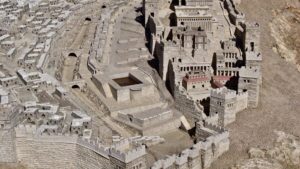
When one hears the name Pontius Pilate, an indelible image comes to mind: the infamous tunic-and-toga cladded Roman prefect of Jerusalem who played a salient role in the judgment, conviction and crucifixion of Jesus. Though this remains the popular depiction of the man, scholarship and archaeology has, over the years, painted a more complex portrait of this, the Roman Emperor’s official representative to the ancient city. He was also a governor assigned the thankless task of negotiating and, at times ruthlessly, managing volatile and resistant, adversarial groups within the population.
_____________________________
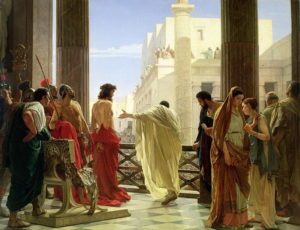
_____________________________
And like King Herod the Great himself, he was also, albeit to a lesser degree, a builder.
So suggests the findings of a recent study published by Nahshon Szanton, Moran Hagbi, Joe Uziel and Donald T. Ariel in Tel Aviv: Journal of the Institute of Archaeology of Tel Aviv University, which details new excavation findings that lead researchers to conclude that a street in Jerusalem leading to the Temple Mount, the largest urban building project in Jerusalem in antiquity, was constructed under Pilate’s governance.
Prior Excavations
Excavations on what has been called the ‘stepped street’ actually began in the late 19th century. Since then, numerous researchers have attempted to find answers to research questions, including the timeframe of the street’s construction. Historically, one consensus suggests the time range between Herod and his grandson, Herod Agrippa—which places the construction timeline anywhere between 37BCE and 66CE.
There have been a total of fourteen excavations on the stepped street since 1867, with each new dig unveiling more of the street’s history. The first two excavations, ranging approximately from 1867 to 1897, revealed a drainage channel that ran the course of the street, appearing in both excavations in different areas of the site. The street has been traced from the southern gate near the Siloam Pool north to the Temple Mount. Material evidence from a 2007-8 excavation conducted by Onn yielded ceramics within the pavement that provided a secure date within the 1st Century CE. Years later in 2011, Shukron recovered two ritual baths—one next to the Western Wall, and one further north—which contained coins that could be dated between 17/18 CE and 24/25CE in the first bath, and 5/6 CE during the rule of Augustus in the second bath.
According to new data, however, researchers have been able to narrow down the street’s construction significantly. The new data suggests construction on the stepped street began after 17/8 CE, and that the project was completed after 30/1 CE and no later than 41/2 CE……….
Current Excavations
Since 2013, two excavations have exposed elements related to the stepped street. The first location was at the southern extent of the Tyropean Valley, exposed from the Siloam Pool for a length of 220m. This area has been designated Area S. Here, the excavation team has discovered that the street measures approximately 7.5m wide, with 0.6m curb stones that have been finely carved from limestone, making the street wider than 8m when the curb is included. Artifacts recovered beneath a thick destruction layer above the street feature include pottery sherds, glass, metal, and—most interestingly—coins dating to the days of the First Jewish Revolt. This means that the street was destroyed and no longer used after 70 CE. Probes were dug in several locations beneath the street pavement, yielding more material evidence providing a terminus post quem for the construction of the street. A total of 22 coins were found in three probes, with the most recent coin dating back to 30/1 CE during the rule of Pontius Pilate.
At a second location, 360m north of Area S, archaeologists excavated the southwest corner of the Temple Mount. Alternating layers of fill yielded pottery, glass, animal bones, and coins dated back to the 1st Century CE. Three chambers along the wall that measured 2m x 2m were also excavated in this area, which contained pottery—including a tall stand dating to the 1st Century CE—animal bones, charcoal, and more coins. There were 79 coins found in these fills, with the most recent dating back to the rule of Tiberius, approximately 17/8 CE to 24/5 CE. The walls were built before the street; we know this because the coins in the construction fill of the drainage system match with the coins found beneath the street.
The study presented by Szanton, Hagbi, Uziel and Ariel (noted above) presents evidence that backs up previous claims that the street’s construction took place in the 1st Century CE. The most recent data presented in this study places the terminus post quem at 30/1 CE. The excavation of 101 coins made reevaluating the dating possible, allowing researchers to narrow down the date of construction even further. Based on their findings, the researchers argue that the construction of the stepped street had to be attributed to the governing prefect prior to Agrippa I. This would be a prefect under Tiberius’ rule. Since there were many prefects in Jerusalem at different times, it is nearly impossible to say for certain the exact prefect stationed in the city at the time of the street construction as there are no written records to confirm. However, the current consensus among researchers is that the street was built under Pontius Pilate’s rule.
__________________________

Location map, marking excavation sites. D. Levi, IAA; printed by permission of the Survey of Israel.
__________________________
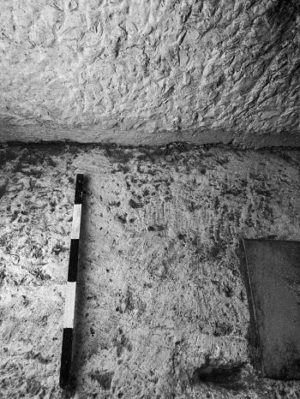
The pavement of the street and the solid foundation that was exposed in a place where no paving stones were preserved. A. Peretz, IAA
__________________________
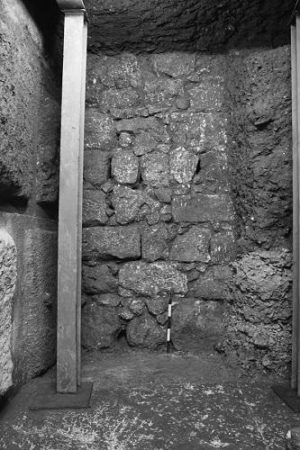
View of the foundations of the Western Wall (left) and the retaining wall that abutted it, built on bedrock (below). To the right are the constructive layers that filled the support system. M. Hagbi, IAA
__________________________
Pontius Pilate the Builder
Pontius Pilate was the most prominent prefect during the beginning of construction (17/8 CE-24/5 CE) as well as its completion (40/1 CE). We know the street’s construction was completed prior to 40/1 CE because of the lack of coins minted by Agrippa I, who would have minted coins starting in 40/1 CE. Therefore, the street’s construction must have been completed no more than between 30 CE and 40 CE. This also means that the construction would have begun in the 20s. There are two dates that are debated as the start of Pilate’s reign: 19 CE, and 26 CE. However, the range of construction dates proposed by the researchers matches both contested dates of the start of Pilate’s reign, which further supports the contention that the street was built under his rule. In addition to this, Pilate had a history of building projects with his name attached. Although the archaeological evidence is still scant compared to that of Herod’s building projects, in addition to the street, the construction of the aqueduct has also been attributed to the Roman prefect, as was the construction of the Tiberieum in Caesarea. Thus it can be argued that the stepped street is the second Jerusalem building project to be attributed to a Roman governor, along with the aqueduct, both of which can be attributed to Pilate.
___________________________

A single inscription by Pilate has survived at the ancient site of Caesarea, on the so-called “Pilate Stone”. The (partially reconstructed) inscription is as follows: “Tiberium [?of the Caesareans?] Pontius Pilate, Prefect of Judea [ .. has given?]”. The stone attests to Pilate’s title of prefect and the inscription appears to refer to a building called a Tiberieum at Caesarea. Wikimedia Commons, Public Domain Image
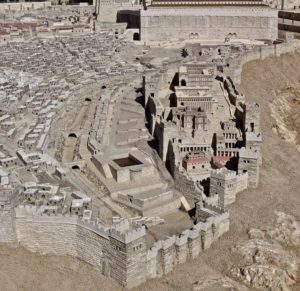
Model of the City of David, in the south of the Old City of Jerusalem, where the stepped street was constructed passing near the Siloam Pool close to where archaeologists excavated and exposed a portion of the street. Berthold Werner, Wikimedia Commons public domain image
___________________________

Exposed portion of the stepped Pool of Siloam. Abraham, Wikimedia Commons public domain image
___________________________
Keeping the Peace
While depictions of the prefect are typically quite negative in the historical sources, Pilate’s history of building projects and reign in Jerusalem suggest a man who was clearly a loyal officer of Rome and Caesar, and who strove for stability in the province for which he was responsible. The construction of the aqueduct and the large stepped street were building improvement projects likely meant to glorify Jerusalem by introducing quality architecture from the Roman world. In the case of the stepped street, Pilate constructed a convenient road for the people of Jerusalem to travel on going to and from the Temple Mount from the southern gate of the city by the Siloam Pool, thus making the trek to their place of worship easier.
Though Pilate could arguably be placed on the list of the world’s great villains, one could also make a case that he was also doing what any Roman prefect in an occupied community would have been tasked to do—keeping the peace in any way he could.




